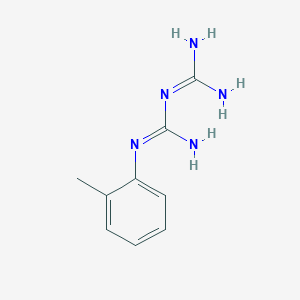Details of the Drug Inactive Ingredient (DIG)
| Full List of Biological Targets of DIG (DBTs) Regulated by This DIG | ||||||
|---|---|---|---|---|---|---|
| G-protein coupled receptor (GPCR) | ||||||
| DBT Name: Serotonin receptor 3A (5HT3A) | Click to Show/Hide | |||||
| Detailed Information |
DBT Info
 click to show the detail info of this DBT click to show the detail info of this DBT
|
|||||
| Experiment for Assessing the Biological Activity of the Studied DIG on This DBT | ||||||
| Biological Activity | Ki = 88 uM (tested by experiment) | [1] | ||||
| Tested Species | Homo sapiens (Human) | |||||
| UniProt ID | 5HT3A_HUMAN | |||||
| DBT Name: Trace amine receptor 1 (TAAR1) | Click to Show/Hide | |||||
| Detailed Information |
DBT Info
 click to show the detail info of this DBT click to show the detail info of this DBT
|
|||||
| Experiment for Assessing the Biological Activity of the Studied DIG on This DBT | ||||||
| Biological Activity | EC50 = 1700 nM (estimated based on the structural similarity with CHEMBL291064 ) | [2] | ||||
| Structural Similarity | Tanimoto coefficient = 0.954022989 | |||||
| Tested Species | Mus musculus (Mouse) | |||||
| UniProt ID | TAAR1_MOUSE | |||||
| DBT Name: Alpha-1A adrenoceptor (ADA1A) | Click to Show/Hide | |||||
| Detailed Information |
DBT Info
 click to show the detail info of this DBT click to show the detail info of this DBT
|
|||||
| Experiment for Assessing the Biological Activity of the Studied DIG on This DBT | ||||||
| Biological Activity | EC50 = 5 uM (tested by experiment) | [1] | ||||
| Tested Species | Homo sapiens (Human) | |||||
| UniProt ID | ADA1A_HUMAN | |||||
| DBT Name: Alpha-2A adrenoceptor (ADA2A) | Click to Show/Hide | |||||
| Detailed Information |
DBT Info
 click to show the detail info of this DBT click to show the detail info of this DBT
|
|||||
| Experiment for Assessing the Biological Activity of the Studied DIG on This DBT | ||||||
| Biological Activity | IC50 = 7.1 uM (tested by experiment) | [1] | ||||
| Tested Species | Homo sapiens (Human) | |||||
| UniProt ID | ADA2A_HUMAN | |||||
If you find any error in data or bug in web service, please kindly report it to Dr. Zhang and Dr. Mou.

